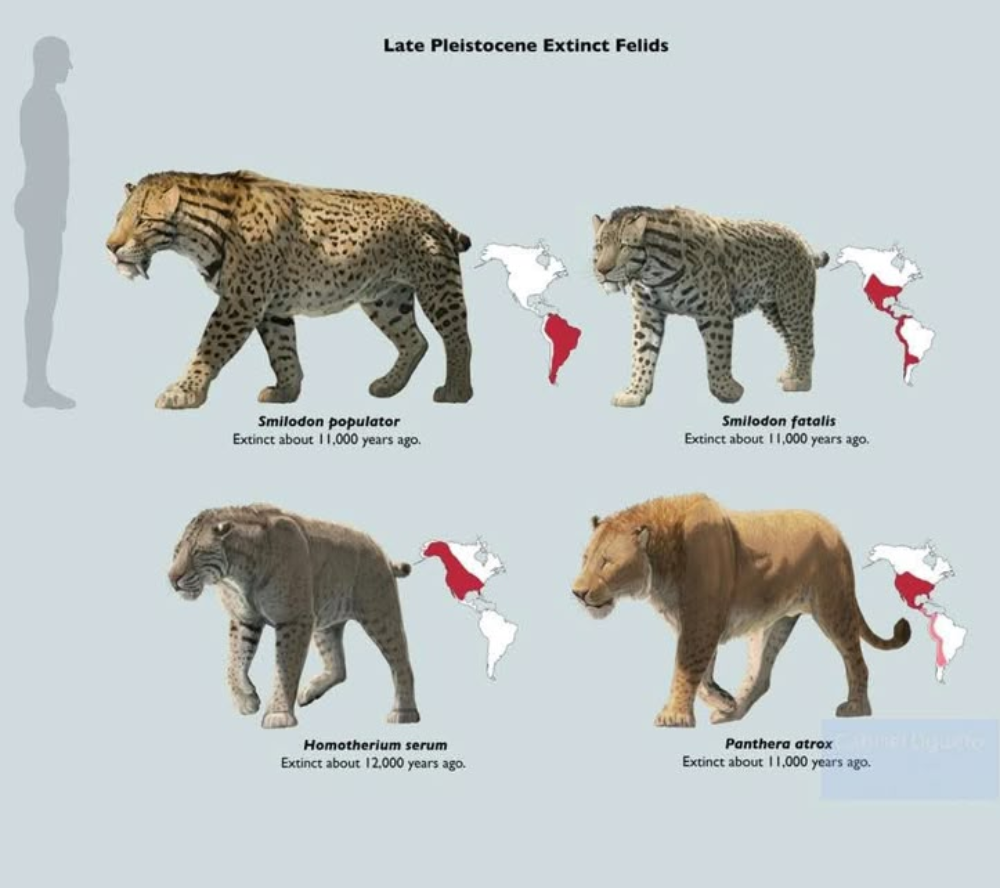Title & Overview
The image presents a concise overview of four formidable Late Pleistocene felids (big cats) that went extinct around the end of the last Ice Age (~12,000–11,000 years ago). The focus is on their extinction timelines, with implied emphasis on their ecological roles and physical traits.

Key Elements
-
Species Listed:
-
Smilodon populator: Largest saber-toothed cat, South America.
-
Smilodon fatalis: Iconic North American saber-tooth (e.g., La Brea Tar Pits).
-
Homotherium serum: Scimitar-toothed cat, adapted for endurance running.
-
Panthera atrox: American lion, one of the largest felids ever.
-
-
Extinction Dates:
-
All species vanished within a narrow window (12,000–11,000 years ago), coinciding with:
-
Quaternary extinction event (loss of megafauna).
-
Climate change (end of Ice Age).
-
Human expansion (overhunting debate).
-
-
-
Visual Inference:
-
Likely includes silhouettes or illustrations of each cat (e.g., Smilodon’s saber teeth, Panthera atrox’s muscular build).
-
May group species by lineage (e.g., machairodonts vs. pantherines).
-
Scientific Significance
-
Adaptive Diversity: Highlights varied hunting strategies:
-
Smilodon: Ambush predator with massive canines for killing large prey.
-
Homotherium: Long-limbed for pursuit in open habitats.
-
-
Extinction Patterns: Reinforces the vulnerability of apex predators to ecosystem collapse.
Suggested Improvements
To enhance educational value:
-
Add Comparative Data:
-
Size comparisons (e.g., Panthera atrox vs. modern lion).
-
Range maps (e.g., Smilodon populator in South America).
-
-
Include Key Traits:
-
Saber teeth: Explain function (precision killing vs. social display).
-
Habitat: Link to prey (e.g., mammoths, giant sloths).
-
-
Timeline Context:
-
Overlay with human migration into the Americas (~15,000 years ago).
-
-
Visual Upgrades:
-
Color-coding by lineage (machairodonts in red, pantherines in gold).
-
Icons for diet (carnivore), hunting style (ambush vs. chase).
-
Errors to Note
-
Typo: “fatells” → Correct to “fatalis” (Smilodon fatalis).
-
Missing Data: No mention of:
-
Physical stats (e.g., S. populator weighed ~880 lbs).
-
Fossil sites (e.g., La Brea Tar Pits for S. fatalis).
-
Final Assessment
Strengths: Clean, focused layout; clear extinction timeline.
Weaknesses: Lacks depth on biology/ecology; minimal visuals.
Rating: 7/10 (Solid foundation but needs expansion).
Perfect for: Science classrooms, paleontology infographics, or museum displays.
Fun Fact: Homotherium’s teeth were serrated like steak knives—ideal for slicing tough hide!
